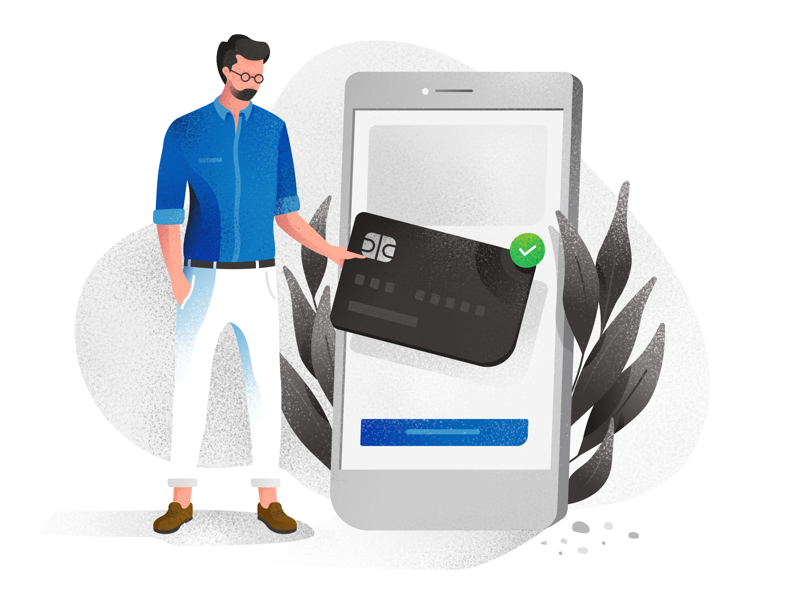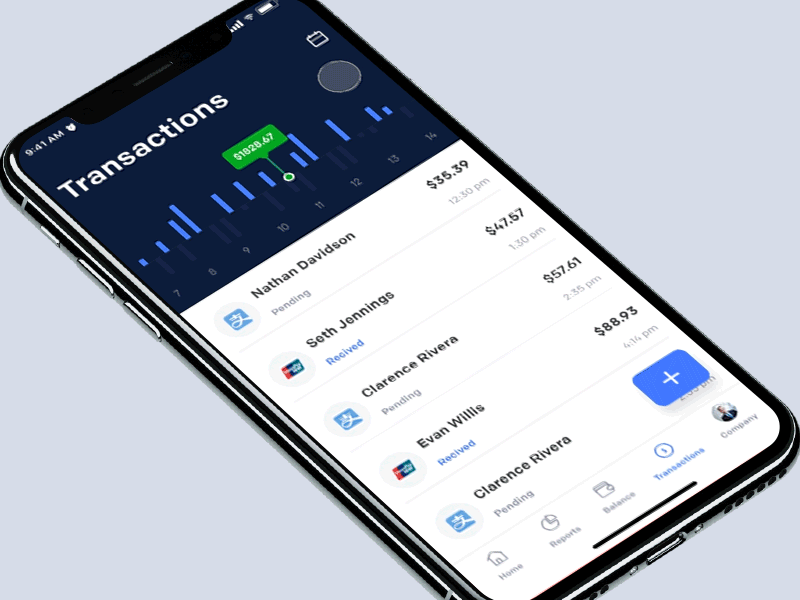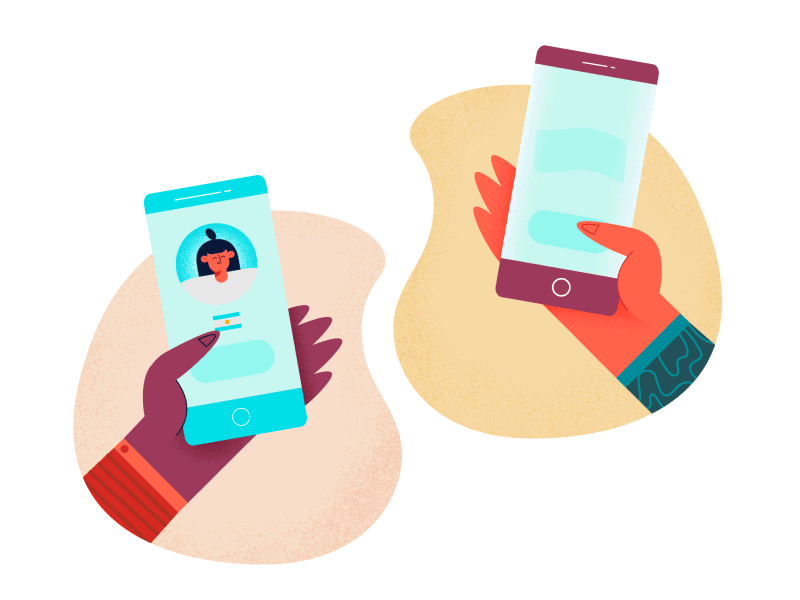Retail banks have offered reward programs for years. But customers no longer perceive these programs as proper rewards for their loyalty. They are becoming more selective in choosing companies that offer them the most personalized benefits.
At the same time, advances in digital technology are opening up new opportunities for businesses in the financial sector, such as banks, to improve customer retention.
How to maintain customer loyalty in the banking industry?
1. Improve the customer experience
2. Create personalized products
3. Provide rewards
4. Leverage technology

Illustration by Andrew McKay
Сustomer loyalty management: digital first
Small banks are often afraid of being out-invested by big national banks. However, even regional banks can win the competition if they position themselves as technology innovators. Customers today are more loyal to banks that are digitizing financial services, as it saves them time and effort.
Virtual wallets, digital deposits, mobile banking applications, and other innovations significantly improve the customer experience.
The Texas-based Frost Bank provides an excellent example of progressive banking digitization. In 2000, Frost Bank became the first regional bank in the US to launch online banking.
The bank provided electronic deposits, encouraged customers to join the Zell virtual wallet network, and allowed customers to freeze their debit cards simply by responding to text messages. Thus, Frost Bank topped the competition among US banks according to the Net Promoter Score.

Animation by Johny Vino
8 tips to increase and maintain customer loyalty in banking
- Know your customer
- Leverage digital customer adoption
- Create an omnichannel experience
- Use mobile wallets for customer loyalty management
- Personalize the digital banking experience
- Work with a younger Gen Z audience
- Incorporate a banking CRM system
- Apply gamification in banking
A Deloitte survey shows that only 19 percent of bank customers can be characterized as truly loyal to their bank.
To increase customer satisfaction and customer loyalty in the banking sector, financial institutions should create customized banking software. Here, we go over a few tips and solutions for digital banking.
1. Know your audience
It may be obvious, but it’s true: in order to effectively attract customers, you first need to know them.
Therefore, it’s imperative that every bank is staffed with professionals who can read and interpret market data to manage customer relationships. For this reason, financial institutions require new roles such as data analyst and CRM specialist.
Based on data, banks are building more effective marketing campaigns more easily by taking into account the characteristics of their target audiences. They can reach those audiences through personalized messages and through different channels.
2. Leverage digital customer adoption
The products and services that finance and banking companies offer can be complex and difficult to explain.
Often, the onboarding process ends with several interactions with clients aimed at collecting their information and completing a loan application. However, there can be many more points of interaction if you get creative.
Customer onboarding is an excellent opportunity to show customers that a bank cares about them. For example, you can do this by creating an online assistant in your mobile banking app that helps customers start using new financial products.
How to make onboarding smoother:
- Pay attention to creating intuitive navigation
- Develop a mobile or web experience that can solve all customer problems online
- Build a trustworthy online identity verification system
- Enable autofill to avoid asking customers the same questions twice
- Provide fast access to accounts or products after onboarding is complete
3. Create an omnichannel experience
With the advent of new technologies, today’s consumer often connects to multiple devices at the same time.
Companies in the financial sector must take this into account. It means they have to develop a communication strategy capable of exploiting all touchpoints. They also have to create a network in which various channels are properly integrated.
If in doing so a bank properly collects and interprets data, it can even arrive at predictable risk and service management so it can anticipate the needs of each client.
4. Use mobile wallets for loyalty card management
The possibility for digital banks to manage loyalty programs directly from a digital wallet can significantly simplify the user experience and increase user loyalty.
Capital One has become one of the first companies in the banking industry to start incorporating this innovation. Capital One manages customer loyalty programs through a mobile wallet. Its customer loyalty programs are some of the most successful in the realm of digital banking.
DBS Bank Singapore gives us another excellent example of how to build customer loyalty in banking. Its mobile wallet, DBS PayLah!, is the fastest-growing digital wallet in Singapore, with more than 785,000 users and 15,000 P2P transactions per day.
One of DBS Bank Singapore’s methods to boost customer loyalty in banking is allowing customers to open new deposit accounts online and transfer money in real time using QR codes.
5. Personalize the digital banking experience
Distributing product-oriented messages is no longer enough for your product or service to have a dominant market position. On the contrary, banks should gradually shift their focus to the customer. In other words, marketing must become customer-centric.
Clients, their needs, and their requirements should be at the center of attention.
A great example of personalizing the banking experience is S&T Bank’s My Reward program for clients who often use debit cards. The system offers personalized rewards cards designed according to the online shopping preferences of S&T customers.
My Reward shows users’ favorite stores with a full range of in-store and online offers and discounts. This approach takes into account the tastes and preferences of each customer. Thus, it provides even more opportunities for ongoing interaction with the bank and increases customer retention.
6. Engage Generation Z
The future is now dictated by a younger generation of tech-savvy customers — Generation Z. Brands will lose out if they don’t adjust their traditional systems with innovations that satisfy Gen Z’s needs — including in the financial sector.
For example, Zions Bank has created the Pays for A’s program to reward students who have been particularly diligent in their studies and support their education. The system is also aimed at student engagement and motivates students to use more financial services in the future.
The Pays for A’s program lets students earn one dollar for each A on a report card, and this money is deposited right to a deposit account at the bank.
Furthermore, Zions Bank has organized a lottery for students, giving each participant the chance to earn a bonus of $100 or even a $1000 scholarship. It sounds like an awesome opportunity for students and can considerably drive the loyalty of this demographic.
This loyalty program also helps Zions Bank collect data about students and build a new target audience for their future marketing campaigns.
7. Incorporate a banking CRM system
CRM systems enable banks to run smart and highly personalized reward programs based on efficient customer segmentation. CRMs allow you to keep a whole customer database in one place and easily manage contacts of different customer groups.
A banking CRM helps to accurately segment a bank’s target audience according to income and demographic data, lifestyle, and customer behaviors. With the data they need, banks can identify and target the most profitable customers. Data also helps them identify and stop ineffective loyalty programs.
Find out more about banking software development with S-PRO. We develop complex banking software that drives growth and creates value in the financial sector.
8. Gamify loyalty programs
Gamification is often used in mobile apps and on websites as a tool for engagement and customer loyalty in the retail banking sector. By applying gamification elements in customer loyalty programs, you can boost the popularity of these programs among your target audience.
Imagine a cute and funny pop-up congratulating users for receiving bonuses for maintaining a certain balance for a particular period.
Measuring Customer Loyalty in Banking: Metrics and Tools
Several quantitative metrics give insight into customer satisfaction and loyalty in the banking industry:
- Customer Effort Score (CES). Measures how much effort a customer has to put in to get their issues resolved or questions answered. The lower the score, the less they struggle with the service or product.
- Customer Churn Rate. This is the rate at which customers close accounts. A lower churn rate signals higher customer loyalty and retention.
- Customer Retention Rate. The percentage of customers that remain with a bank over a given period. A high retention rate indicates strong customer loyalty. Most banks aim for a retention rate of over 90%.
- Net Promoter Score (NPS). Assesses customer loyalty by gauging the probability of customers recommending a bank to others. Customers respond on a scale of 0 to 10. Higher NPS indicates stronger loyalty.
These metrics provide objective benchmarks banks can track over time to gauge developing customer loyalty trends.
Banks can also utilize qualitative methods to gain insights into customer satisfaction:
- Surveys. Online or phone surveys can help banks form a clear picture of customers’ satisfaction with the products, services, facilities, and staff. Well-designed surveys provide detailed insights into drivers of customer satisfaction and areas for improvement.
- Social Media Monitoring. Monitoring social platforms for mentions of a bank helps assess sentiment.
- Focus groups. By bringing together a small group of customers, banks can gain qualitative insights into their experiences, perceptions, and expectations. Focus groups allow for in-depth discussions that uncover valuable information that may not emerge through surveys alone.
- Customer Feedback Management Systems. Software systems that collect, analyze, and provide actionable insights from various sources like surveys, online reviews, social media, and call center interactions. These tools help identify trends and areas for improvement to build better customer loyalty.
By leveraging these metrics and methods, banks can develop a well-rounded view of customer loyalty. They can identify problem areas, recognize customer needs, and continuously refine products and services to nurture lasting customer relationships.
Improved loyalty in the banking sector leads to higher customer lifetime value, reduced churn, positive word-of-mouth, and ultimately greater profitability.
Case Studies: Successful Customer Loyalty Programs in Banking
To foster loyalty, the banking industry has implemented innovative loyalty programs to reward its customers for their continued patronage. Here are several successful examples:
Bank of America’s Preferred Rewards
Bank of America, one of the largest financial institutions in the US banking sector, offers a comprehensive customer loyalty program called Preferred Rewards. This multi-tiered program rewards customers based on the total balances they maintain across Bank of America accounts. There are four tiers:
- Gold. For customers with $20,000 to $50,000 in combined balances. The incentives include a 5% hike in the interest rates on savings accounts, 25% additional credit card reward points, and zero fees for using ATMs not owned by Bank of America.
- Platinum. For customers with $50,000 to $100,000 in combined balances. Added benefits include a 10% increase in savings account interest rates and 50% more credit card reward points.
- Platinum Honors. For customers with over $100,000 in combined balances. The highest benefits include unlimited ATM fee rebates, a 20% increase in savings account interest rates, and 75% more credit card reward points.
- Diamond. For customer with over $1 million on their account. It includes all the benefits of the Platinum Honors tier plus unlimited no-fee ATM transactions and other lifestyle benefits like exclusive incentives on luxury car purchases.
Bank of America offers cashback and travel rewards for customers who use their Bank of America credit cards. Customers can exchange their earned rewards for money, retailer gift certificates, vacations, and products.
Citibank’s Citi ThankYou® Rewards
Citibank is a leading global bank that provides an extensive range of financial offerings:
- personal and business loans, mortgages, and IRAs;
- different types of credit cards that tie into Citi’s rewards program;
- bonuses for opening an eligible checking account.
Customers can exchange the points they’ve accumulated for cash rebates and use them for airline miles or hotels. Points can also be used to shop, dine, or gift to friends.
Citi offers various reward choices beyond simple cash rebates. Cardholders have the option of directly exchanging their accrued points for merchandise at popular stores such as Amazon, CVS, Best Buy, BP, and Shell. For those preferring more flexibility, points can instead be redeemed for merchant gift cards that can be used at an assortment of dining establishments, travel companies, and other retailers.
JP Morgan’s One Card
Another juggernaut in the banking industry, JP Morgan, isn’t falling behind the other Big Four banks in the US by offering its own loyalty program. Their version is quite straightforward, as customers using a JP Morgan card accrue points at a rate of one dollar per point. Interestingly, the points received through this program have no expiration date, which is somewhat unusual for such programs.
The points can be spent on real-life benefits like gift cards, travel perks, and various merchandise, incentivizing everyone to collect them. It’s a simple but effective solution that promotes customer loyalty.
Capital One Rewards
This major American bank offers several programs encouraging customers to join it and use its cards. For example, the Quicksilver Rewards program provides unlimited 1.5% cashback on all purchases. Then there are travel rewards, too, which give customers miles to travel anytime they conduct a transaction.
Like other banks, Capital One offers a variety of cards that are affected by the reward system. Those seeking travel rewards may choose among several options depending on their income and typical monthly spending. Thanks to that, even those with a smaller level of spending may be able to get travel perks on their cards.
Wells Fargo Rewards
This Big Four bank is a household name worldwide and has a rewards program of its own, with various cards geared toward different purposes. There are options such as 2% cashback on all purchases, extra points on hotels specifically, and cards that provide extra miles.
As usual, better rewards come with cards with special conditions centered mainly around how much a customer is willing to spend. This pushes people to make more transactions, but realistically, it still limits the opportunities for new customers to get extra rewards. Thankfully, even the baseline level of perks is quite good and motivates clients to stick around.
Banks can cement lasting relationships with account holders by developing customer loyalty programs.
Leveraging Technology to Foster Customer Loyalty in the Banking Industry
The banking industry is facing immense competition as customers now have more choices than ever. With new financial technology companies and online banks entering the market, traditional banks focus on developing customer loyalty to retain existing clients and attract new ones.
Banks can leverage emerging technologies like artificial intelligence, mobile apps, and blockchain to boost customer loyalty in the following ways:
Personalized Communication Through AI Chatbots
Artificial intelligence-powered chatbots allow banks to provide personalized and seamless conversations with customers. Chatbots can answer customer queries 24/7 and use natural language processing to understand context and intent. They can also access customer data to provide tailored solutions. Chatbots enhance customer experience and foster loyalty by enabling quick issue resolution and timely responses.
Enhanced Accessibility with Mobile Banking Apps
Mobile banking sector apps have simplified the lives of the customers significantly, providing them with banking on the go. Users can view account balances, transfer money between accounts, and settle invoices at any moment and from any location. Features like biometric login, personal finance management tools, and customized notifications in the app provide a seamless experience and fosters loyalty.
Blockchain for Enhanced Security
Blockchain technology offers decentralized, transparent, and secure transactions, which builds trust. Banks can leverage blockchain to prevent fraud, enhance security, and promote loyalty. For instance, blockchain-enabled digital IDs can prevent identity theft and fraudulent transactions. The tamper-proof distributed ledger boosts confidence in the banking system.
Data Analytics for Personalized Offerings
Banks can tap into customer data and analytics to derive insights into purchasing behavior and life events. Personalized offerings based on individual preferences and needs boost satisfaction and loyalty. Recommendation engines can prompt relevant promotions at opportune moments.
By embracing emerging technologies, banks can provide seamless omnichannel banking, secure transactions, customized offerings, and communications to develop lasting customer relationships. The human touch enhanced by technology will foster loyalty in the digital age.

Animation by Latham Arnott
Boosting Customer Loyalty in Banking Through AI Innovations
Keeping customers engaged can be difficult when dozens of businesses and apps compete for their attention. The best way to ensure customer loyalty is to understand their needs and make them feel valued. Doing so with regular analytics and customer service can be expensive and time-consuming, making it a deal-breaker for a smaller bank. But that’s exactly where AI comes in.
Using AI-powered analytics, you can assess what your client base lacks and which measures to take to fill that gap. This may mean adding gamification features or simply providing more personalization so that customers feel important. The trick here is that AI eliminates guesswork as it highlights the weaker points of banks and their services.
AI can also automate the basics of customer service, an essential aspect of the banking industry. It can be used in chatbots to solve technical issues and process new clients’ onboarding. A sufficiently trained AI model will provide personalized tips and assistance with typical requests no worse than a human employee would but on a much wider scale.
It’s also possible to analyze customer behavior patterns to understand what precedes a customer switching to a different bank or giving negative feedback. This way, you’ll be able to anticipate any unwanted shifts and adapt to keep clients happy, minimizing churn.
In general, AI should be treated as an enhancing tool for the customer loyalty plan you already have in action. It can help predict future trends, too, by analyzing the market at large and letting you apply new customer-enticing features. However, ultimately, it’s just one of the many things you can use to keep your clientele engaged.
To summarize: customer loyalty in retail banking
To stay competitive on today’s market, you need to adjust all your company’s processes to the requirements of the new era of digital transformation.
Simply going digital isn’t enough to increase customer engagement and loyalty in the banking sector. The points listed above will allow you to preserve your community, influence attitudes towards your company, and even turn your customers into true brand ambassadors.
What the right partnership gives
If you have any further questions about the meaning and importance of customer loyalty in banking or need a clearer idea of where to start, you can read more about software development for banks and financial institutions. Or you can make an appointment with us and we will be happy to answer your questions during a call.
Our team is always glad to help. We can also consult on how to measure and increase customer loyalty in any financial institution.
S-PRO has extensive expertise and domain knowledge that allows us to develop mobile banking applications that will give you lots of benefits.
We partner with world-known companies in the economics, analytics, regulatory compliance, and blockchain consulting fields to help them overcome FinTech development challenges and create excellent digital products.





